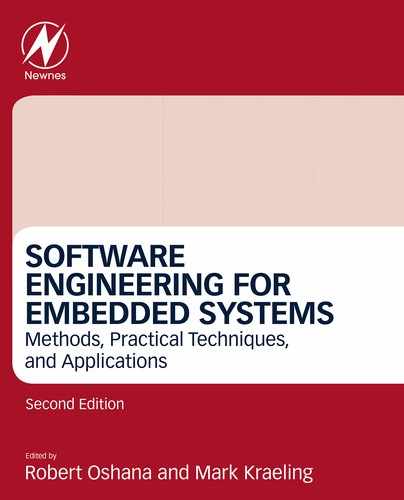Table of Contents
1: Software Engineering for Embedded and Real-Time Systems
4 Example of a Hard Real-Time System
5 Real-Time Event Characteristics
6 Challenges in Real-Time System Design
7 The Embedded System’s Software Build Process
8 Distributed and Multiprocessor Architectures
9 Software for Embedded Systems
10 Hardware Abstraction Layers for Embedded Systems
2: Software Development Process
7 Rolling It Together: Agile Development
3: Embedded and Multicore System Architecture—Design and Optimization
2 The Right Way and the Wrong Way
5 Helping the Compiler and Build Tools
4: Basic Programming Techniques
4 Target System Configuration and Initialization
5: Programming and Implementation Guidelines
2 Starting the Embedded Software Project
1 Foreground/Background Systems
3 RTOS (Real-Time Operating System)
5 Determining the Size of a Stack
11 The Clock Tick (or System Tick)
8: Software and Compiler Optimization for Microcontrollers, Embedded Processors, and DSPs
3 Understanding the Embedded Target Architecture
4 Basic Optimization Goals and Practices
5 General Loop Transformations
9: Embedded Software Quality, Integration, and Testing Techniques
2 Why Should We Test Software?
4 When Should Testing Take Place?
9 Implementing a Test Solution Environment
10: Embedded Multicore Software Development
1 Symmetric and Asymmetric Multiprocessing
3 Look for Parallelism Opportunities
4 Multicore Application Locality
5 Multicore Programming Models
6 Performance and Optimization of Multicore Systems
7 Language Extensions Example—OpenMP
11: Safety-Critical Development
3 Faults, Failures, Hazards, and Risk Analysis
4 Safety-Critical Architectures
5 Software Implementation Strategies
3 Moving From the Linux Kernel to User Space
4 Life of a Packet in a Native Linux Network Stack
5 Networking Performance Optimization Techniques
6 Case Studies: Covering Microcontrollers to Network Processors
2 History and Device Progression
5 Internet of Things Architecture
6 Communications Used in Internet of Things
8 Internet of Things Development Challenges
3 Life Cycle of a Secure Embedded System
5 Components of Secure Embedded Systems
15: Machine Learning at the Edge
2 What Is Artificial Intelligence
6 k-NN (Nearest Neighbor) Algorithm
